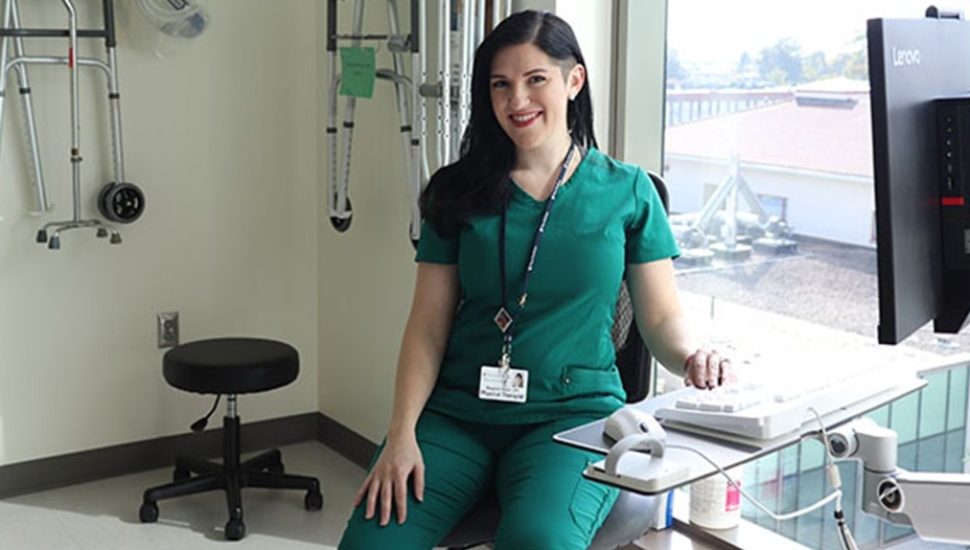A Day in the Life of a Chester County Hospital Physical Therapist

A society in which children are assigned their jobs at age 12 — this is the world that author Lois Lowry paints in her novel, The Giver. Across the country, plenty of middle school children explore this fictional society, but few children walk away with a vision of their own future.
Except for Dr. Meaghan Harper, Physical Therapist at Chester County Hospital.
In the novel, the main character is assigned the noble task of caring for an elderly gentleman in his community. As a sixth-grader, Harper loved this concept of being assigned a career — not to mention one that centers on caring for others. After reading the novel, her class took a career placement test, and she read her top result: physical therapist.
Coincidentally, her best friend’s father happened to be a physical therapist at a local independent and assisted living facility. After just a few days of observing him, Harper was hooked — and she was also determined to become Dr. Meaghan Harper.
“Every step I took in life after that was to achieve my goal of becoming a physical therapist,” said Dr. Harper.
Dr. Harper is an acute care physical therapist at Chester County Hospital, which means she practices in the hospital setting. She works with patients with planned surgeries or unplanned medical issues (such as a stroke), doing everything from determining their needs for discharge to recommending equipment and services to, of course, guiding them in physical therapy exercises.
Dr. Harper has been a physical therapist for eight years, with the recent accomplishment of becoming board certified in geriatric therapy. Here’s what a day in the life of Dr. Harper looks like — and how physical therapy benefits patients right here in Chester County.
A Typical Day as a Physical Therapist
There is no floor for adult patients that Dr. Harper isn’t involved in at Chester County Hospital. From the Emergency Department to the Intensive Care Unit to Labor and Delivery to Orthopaedics, Dr. Harper has a role in them all.
Her day begins by reviewing current patients with a team of other specialists, including physicians, nurses, and social workers. “We all provide our disciplines’ insights as needed,” said Dr. Harper.
Then, she reviews her list of new patients, prioritizing who to see based on their condition, medical stability, and how close they are to getting discharged from the hospital.
During a patient evaluation, Dr. Harper is responsible for assessing a patient’s condition, particularly when it’s safe for them to go home.
“A typical evaluation consists of asking the patient their home setup, what support they usually need or have available, and how they move around,” she said. “I have them attempt to demonstrate their usual locomotion — whether walking, transferring, or using a wheelchair — and compare that to their usual abilities.”
Though she enjoys all aspects of her job, she finds diagnosing and treating Benign Paroxysmal Positional Vertigo (BPPV) particularly fascinating. BPPV is a form of vertigo in which a patient suddenly feels dizzy due to problems in the inner ear. Fortunately, a few simple head movements can help relieve symptoms.
“BPPV is one of those few conditions that really can be significantly helped with ‘one weird trick,'” said Dr. Harper.
Beyond physical therapy itself, Dr. Harper is involved with committee meetings, such as the DEI Council, LGBTQ Subcommittee, and Inter-Hospital Governance Subcommittee for Physical Therapy and Occupational Therapy. She also co-teaches a bi-monthly Joint Surgery Education class, which helps patients prepare for upcoming joint replacement surgery, like knee or hip replacement surgery.
Patient-Provider Communication During Physical Therapy
A physical therapy evaluation requires Dr. Harper to get to know each patient’s condition, which takes time. Because of this, she has to rely on small talk.
Dr. Harper has also learned the differences in how patients communicate with healthcare providers — a key to understanding a patient’s goals. Communication styles can be a result of varying generations, personalities, or simply life experiences.
“Some people prefer the traditional method — ‘just tell me what to do.’ But many people nowadays prefer their care to be more of a cooperative process,” said Dr. Harper. It’s up to Dr. Harper to understand which methods work best for each patient, then adapt to help them achieve their unique physical therapy goals.
A Career and an Opportunity to Make an Impact
Sixth-grader Meaghan Harper may not have known the impact that Dr. Meaghan Harper would make today. It’s one of the reasons she loves her job — because she can help patients both physically and emotionally.
“I love when a patient tells me, ‘I feel better now, thank you.’ Sometimes that’s physically better because they got up and stretched their legs or finally got out of bed. Or, I knew how to position them most comfortably,” says Dr. Harper.
But other times, patients feel emotionally better. Whether through physical therapy, meditation, or mindfulness techniques, Dr. Harper is able to help improve their situation.
“Patients may be afraid of falling, of feeling weak, or of how much help they’ve been needing. Sometimes they feel anxious about their situation, or depressed,” she said. “Making people feel better is an immediate and satisfying reward I get to experience just about every day.”
Dr. Harper recalls one patient, in particular — a Spanish-speaking gentleman who was in a wheelchair after an injury. Prior to physical therapy, he had never been trained how to use his wheelchair properly.
“At first, he was angry with me, and he thought I was trying to get rid of him,” Dr. Harper said. “But with the help of our translators, I was able to make a connection with him.” During therapy, she showed him videos of people living full lives in a wheelchair, and he looked up even more videos on his phone before the next session.
“His whole demeanor changed. He became excited about therapy, learning new skills, and propelling himself around the hospital,” she said.
But Dr. Harper didn’t just have an impact on this patient — he also had an impact on her. After working with him, she was inspired to take a Spanish class to communicate more easily with future patients.
Being a Part of the Chester County Hospital Community
Dr. Harper loves her job as a physical therapist — and she also appreciates the community in which she works. She says it’s a place where she can follow her interests, adhere to her values, and make real change.
“If I’m passionate about social justice, there’s a place for me. If I like baking cakes, there’s a place for me. If I like public speaking, there’s a place for me,” she said.
What’s more, she enjoys the community-based feel of Chester County Hospital. “People know my name and say hello, I feel genuinely seen and valued here, and I’m not just a cog in the machine.”
Since her sixth grade reading of The Giver, Dr. Harper has known that she’s wanted to make a difference in people’s lives. At Chester County Hospital, she does exactly that. Through physical therapy, Dr. Harper helps patients recover, care for their bodies, and realize their full potential each day.
Do You Have Questions About How Physical Therapy Can Benefit You?
Learn more about Chester County Hospital Physical Therapy, Rehabilitation, and Sports Medicine, or find a Chester County Hospital Physical Therapy, Rehabilitation, and Sports Medicine location near you.
Connect With Your Community
Subscribe to stay informed!
"*" indicates required fields















































![95000-1023_ACJ_BannerAd[1]](https://vista.today/wp-content/uploads/2023/03/95000-1023_ACJ_BannerAd1.jpg)




